Cebalrai, Beta Ophiuchi (β Oph), is an orange giant star located 81.8 light-years away in the equatorial constellation Ophiuchus. With an apparent magnitude of 2.749, it is the fifth brightest star in Ophiuchus, after Rasalhague, Sabik, Zeta Ophiuchi, and Yed Prior. Cebalrai and these stars form a large polygon in the sky that makes their host constellation easily recognizable.
Star type
Cebalrai is a giant star of the spectral type K2 III. It has a mass of 1.13 solar masses and a radius about 12.42 times that of the Sun. With an effective temperature of 4,467 K, it is 63.4 times more luminous than the Sun. It has an estimated age of 3.82 ± 1.86 billion years.
Like many other K-type giants, Cebalrai varies slightly in brightness, with fluctuations of 0.02 magnitudes. The star is a member of the Milky Way’s thin disk population. It has a low-eccentricity orbit around the centre of the Milky Way that takes it within 27,300 light-years of the Galactic Centre and as far away as 30,900 light-years. The orbit takes the star up to 620 light-years above or below the galactic plane.
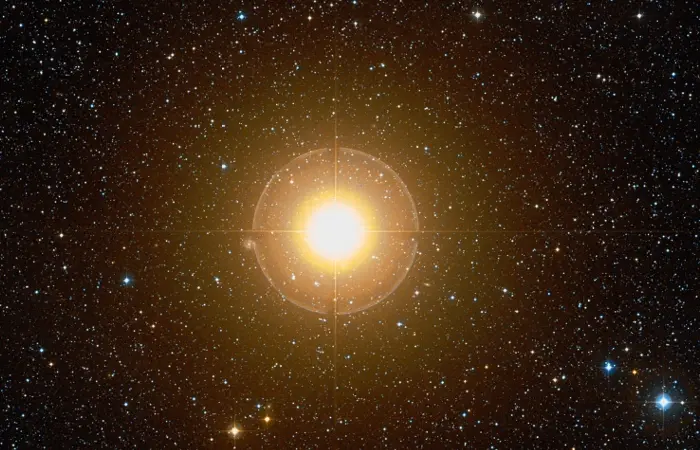
Cebalrai (Beta Ophiuchi), image: Wikisky
Facts
A study of Beta Ophiuchi published in September 1996 reported radial velocity variations with a period of 142.3 days and two shorter periods. The long term period may be the result of rotational modulation of surface features, but the presence of an orbiting planet is also not ruled out. The existence of Beta Ophiuchi b has never been confirmed. If the planet exists, it has a mass of one or more Jupiter masses and orbits the parent star at a distance of 0.6 or more astronomical units.
Name
The name Cebalrai (pronunciation: /ˌsɛbəlˈreɪ.iː/) is derived from the Arabic kalb al-rā‘ī, meaning “the shepherd’s dog.” In ancient Arabic astronomy, the brighter Rasalhague was seen as a shepherd and Cebalrai as his dog. The name was historically also spelled Celbalrai, Cheleb, and Kelb Alrai.
The name Cebalrai was approved by the International Astronomical Union’s (IAU) Working Group on Star Names (WGSN) on August 21, 2016.
In Chinese astronomy, Cebalrai formed an asterism known as Official for the Royal Clan (宗正, Zōng Zhèng) with the fainter Gamma Ophiuchi. Beta Ophiuchi was known as the First Star of Official for the Royal Clan. The asterism was part of the larger Heavenly Market Enclosure, which represented the emperor’s realm.
Location
Cebalrai is easy to find because it is part of a prominent star pattern. It forms the polygon of Ophiuchus with the brighter Rasalhague, Sabik, Zeta Ophiuchi, and Yed Prior and the fainter Kappa Ophiuchi. Rasalhague, the brightest star in Ophiuchus, is found about halfway between the first-magnitude Vega in the constellation Lyra and Antares in Scorpius. Cebalrai lies southeast of Rasalhague, at the northeastern corner of the polygon.
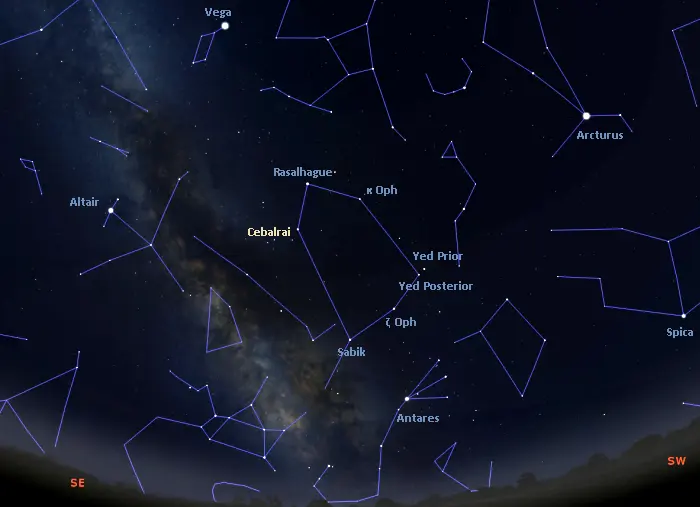
The location of Cebalrai (Beta Ophiuchi), image: Stellarium
Cebalrai can be used to find an asterism known as the Bull of Poniatowski, the remnant of an obsolete constellation of the same name. The V-shaped asterism is formed by 66, 67, 68, 70, and 73 Ophiuchi, and can be used to find Barnard’s Star, the fourth nearest individual star to the Sun (after the three stars in the Alpha Centauri system).
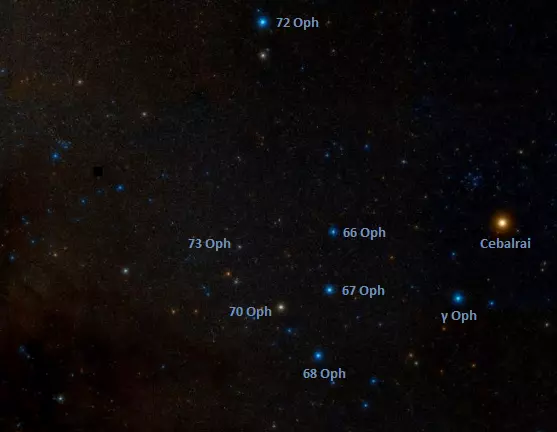
Cebalrai and the Bull of Poniatowski, image: Wikisky
The bright open cluster IC 4665 (Collinder 349, Melotte 179) appears in the same wide field of view as Cebalrai, about a degree northeast of the star. With an apparent magnitude of 4.2, the cluster can be observed in binoculars and small telescopes. It lies 1,400 light-years away.
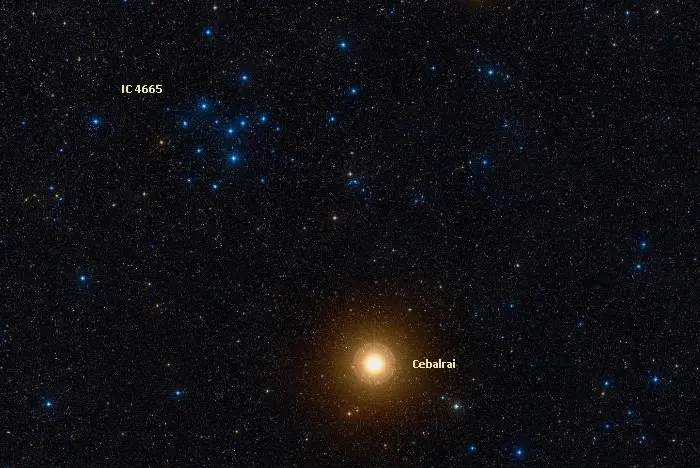
Cebalrai and IC 4665, image: Wikisky
Constellation
Cebalrai is located in the constellation Ophiuchus. The celestial Serpent Bearer is one of the Greek constellations, catalogued by Claudius Ptolemy of Alexandria in the 2nd century CE. In Greek mythology, the constellation is associated with the god Apollo and the healer Asclepius.
Ophiuchus stretches across 948 square degrees of the sky on the celestial equator. It is depicted as a man holding a serpent and it divides the constellation Serpens into two parts, the Serpent’s Head (Serpens Caput) and the Serpent’s Tail (Serpens Cauda). As one of the 15 equatorial constellations, Ophiuchus can be seen from virtually anywhere on Earth for at least part of the year.
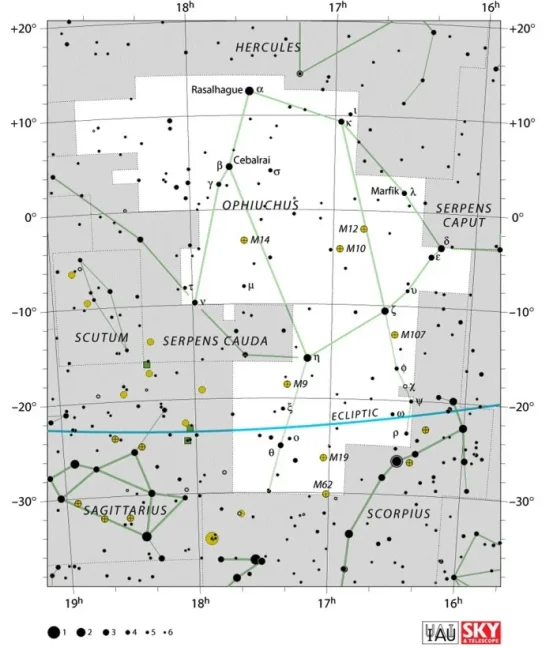
Ophiuchus constellation map by IAU and Sky&Telescope magazine
Ophiuchus hosts many notable stars. The constellation’s brightest star is Rasalhague (Alpha Ophiuchi), a white subgiant that shines at magnitude 2.07 from a distance of 48.6 light-years. Ophiuchus is also home to Zeta Ophiuchi, the nearest O-type star to the solar system, the binary star system Eta Ophiuchi (Sabik), the nearby red dwarf Wolf 1061, home to three confirmed extrasolar planets, the recurrent nova RS Ophiuchi, and the hot blue star system Rho Ophiuchi, surrounded by the Rho Ophiuchi cloud complex, one of the nearest stellar nurseries to the Sun. The constellation also hosts Barnard’s Star, the second nearest star system to the Sun.
Ophiuchus contains a number of bright globular clusters, including Messier 9, Messier 10, Messier 12, Messier 14, Messier 19, Messier 62, and Messier 107. It is also home to the Twin Jet Nebula (Minkowski’s Butterfly, M2-9), a bipolar planetary nebula, the Blue Racquetball Nebula (NGC 6572), the Dark Horse Nebula, a dark nebula that obscures a portion of the Milky Way’s central bulge, and the ultraluminous infrared galaxy (ULIRG) NGC 6240, popularly known as the Starfish Galaxy. Open clusters in the constellation include IC 4665 near Cebalrai and NGC 6633 (the Tweedledum Cluster) near the border with Serpens.
The constellation also hosts Kepler’s Supernova, the remnant of a historical supernova observed in 1064.
The best time of the year to observe the stars and deep sky objects in Ophiuchus is during the month of July, when the constellation is prominent in the evening sky. The entire constellation is visible from locations between the latitudes 80° N and 80° S.
The 10 brightest stars in Ophiuchus are Rasalhague (Alpha Oph, mag. 2.07), Sabik (Eta Oph, mag. 2.43), Zeta Ophiuchi (mag. 2.569), Yed Prior (Delta Oph, mag. 2.75), Cebalrai (Beta Oph, mag. 2.75), Kappa Ophiuchi (mag. 3.20), Yed Posterior (Epsilon Ophiuchi, mag. 3.22), Theta Ophiuchi (mag. 3.26), Nu Ophiuchi (mag. 3.332), and 72 Ophiuchi (mag. 3.73).
Cebalrai – Beta Ophiuchi
| Spectral class | K2 III |
| U-B colour index | +1.253 |
| B-V colour index | +1.170 |
| Apparent magnitude | 2.749 (2.75-2.77) |
| Absolute magnitude | +0.77 ± 0.04 |
| Distance | 81.8 ± 0.3 light-years (25.1 ± 0.1 parsecs) |
| Parallax | 39.2284 ± 0.2027 mas |
| Radial velocity | -12.120 ± 0.0008 km/s |
| Proper motion | RA: 41.45 mas/yr |
| Dec.: +159.34 mas/yr | |
| Mass | 1.13 M☉ |
| Luminosity | 63.4 ± 3.2 L☉ |
| Radius | 12.42 ± 0.13 R☉ |
| Temperature | 4,467 K |
| Metallicity | 0.04 dex |
| Age | 3.82 ± 1.86 billion years |
| Rotational velocity | 5.4 km/s |
| Surface gravity | 2.22 cgs |
| Constellation | Ophiuchus |
| Right ascension | 17h 43m 28.3519097803s |
| Declination | +04° 34′ 02.293206489″ |
| Names and designations | Cebalrai, Beta Ophiuchi, β Oph, 60 Ophiuchi, Celbalrai, Cheleb, Kelb Alrai, HD 161096, HR 6603, HIP 86742, SAO 122671, BD+04°3489, FK5 665, AG+04 2178, GC 24048, GCRV 10239, PLX 4042.00, PPM 164476, UBV 15049, JP11 2883, NSV 23613, IRAS 17409+0435, 2MASS J17432835+0434022, TYC 423-1724-1, Gaia DR2 4473334474601314560, Gaia DR3 4473334474604992384 |